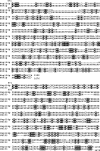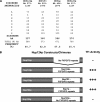Multiple conserved domains of the nucleoporin Nup124p and its orthologs Nup1p and Nup153 are critical for nuclear import and activity of the fission yeast Tf1 retrotransposon
- PMID: 17615301
- PMCID: PMC1951742
- DOI: 10.1091/mbc.e06-12-1062
Multiple conserved domains of the nucleoporin Nup124p and its orthologs Nup1p and Nup153 are critical for nuclear import and activity of the fission yeast Tf1 retrotransposon
Abstract
The nucleoporin Nup124p is a host protein required for the nuclear import of both, retrotransposon Tf1-Gag as well as the retroviral HIV-1 Vpr in fission yeast. The human nucleoporin Nup153 and the Saccharomyces cerevisiae Nup1p were identified as orthologs of Nup124p. In this study, we show that all three nucleoporins share a large FG/FXFG-repeat domain and a C-terminal peptide sequence, GRKIxxxxxRRKx, that are absolutely essential for Tf1 retrotransposition. Though the FXFG domain was essential, the FXFG repeats themselves could be eliminated without loss of retrotransposon activity, suggesting the existence of a common element unrelated to FG/FXFG motifs. The Nup124p C-terminal peptide, GRKIAVPRSRRKR, was extremely sensitive to certain single amino acid changes within stretches of the basic residues. On the basis of our comparative study of Nup124p, Nup1p, and Nup153 domains, we have developed peptides that specifically knockdown retrotransposon activity by disengaging the Tf1-Gag from its host nuclear transport machinery without any harmful consequence to the host itself. Our results imply that those domains challenged a specific pathway affecting Tf1 transposition. Although full-length Nup1p or Nup153 does not complement Nup124p, the functionality of their conserved domains with reference to Tf1 activity suggests that these three proteins evolved from a common ancestor.
Figures









Similar articles
-
The Long Terminal Repeat Retrotransposons Tf1 and Tf2 of Schizosaccharomyces pombe.Microbiol Spectr. 2015 Aug;3(4):10.1128/microbiolspec.MDNA3-0040-2014. doi: 10.1128/microbiolspec.MDNA3-0040-2014. Microbiol Spectr. 2015. PMID: 26350316 Free PMC article. Review.
-
The functionally conserved nucleoporins Nup124p from fission yeast and the human Nup153 mediate nuclear import and activity of the Tf1 retrotransposon and HIV-1 Vpr.Mol Biol Cell. 2005 Apr;16(4):1823-38. doi: 10.1091/mbc.e04-07-0583. Epub 2005 Jan 19. Mol Biol Cell. 2005. PMID: 15659641 Free PMC article.
-
Nuclear import of the retrotransposon Tf1 is governed by a nuclear localization signal that possesses a unique requirement for the FXFG nuclear pore factor Nup124p.Mol Cell Biol. 2000 Oct;20(20):7798-812. doi: 10.1128/MCB.20.20.7798-7812.2000. Mol Cell Biol. 2000. PMID: 11003674 Free PMC article.
-
Nup124p is a nuclear pore factor of Schizosaccharomyces pombe that is important for nuclear import and activity of retrotransposon Tf1.Mol Cell Biol. 1999 Aug;19(8):5768-84. doi: 10.1128/MCB.19.8.5768. Mol Cell Biol. 1999. PMID: 10409764 Free PMC article.
-
The long terminal repeat-containing retrotransposon Tf1 possesses amino acids in gag that regulate nuclear localization and particle formation.J Virol. 2005 Aug;79(15):9540-55. doi: 10.1128/JVI.79.15.9540-9555.2005. J Virol. 2005. PMID: 16014916 Free PMC article.
Cited by
-
Flexible gates: dynamic topologies and functions for FG nucleoporins in nucleocytoplasmic transport.Eukaryot Cell. 2009 Dec;8(12):1814-27. doi: 10.1128/EC.00225-09. Epub 2009 Oct 2. Eukaryot Cell. 2009. PMID: 19801417 Free PMC article. Review.
-
Sumoylation and transcription regulation at nuclear pores.Chromosoma. 2015 Mar;124(1):45-56. doi: 10.1007/s00412-014-0481-x. Epub 2014 Aug 30. Chromosoma. 2015. PMID: 25171917 Free PMC article. Review.
-
Probing the disordered domain of the nuclear pore complex through coarse-grained molecular dynamics simulations.Biophys J. 2014 Sep 16;107(6):1393-402. doi: 10.1016/j.bpj.2014.07.060. Biophys J. 2014. PMID: 25229147 Free PMC article.
-
Nup2 requires a highly divergent partner, NupA, to fulfill functions at nuclear pore complexes and the mitotic chromatin region.Mol Biol Cell. 2015 Feb 15;26(4):605-21. doi: 10.1091/mbc.E14-09-1359. Epub 2014 Dec 24. Mol Biol Cell. 2015. PMID: 25540430 Free PMC article.
-
The Long Terminal Repeat Retrotransposons Tf1 and Tf2 of Schizosaccharomyces pombe.Microbiol Spectr. 2015 Aug;3(4):10.1128/microbiolspec.MDNA3-0040-2014. doi: 10.1128/microbiolspec.MDNA3-0040-2014. Microbiol Spectr. 2015. PMID: 26350316 Free PMC article. Review.
References
-
- Allen N. P., Huang L., Burlingame A., Rexach M. Proteomic analysis of nucleoporin interacting proteins. J. Biol. Chem. 2001;276:29268–29274. - PubMed
-
- Antonin W., Mattaj I. W. Nuclear pore complexes: round the bend? Nat. Cell Biol. 2005;7:10–12. - PubMed
-
- Ball J. R., Ullman K. S. Versatility at the nuclear pore complex: lessons learned from the nucleoporin Nup153. Chromosoma. 2005;114:319–330. - PubMed
Publication types
MeSH terms
Substances
LinkOut - more resources
Full Text Sources
Molecular Biology Databases

